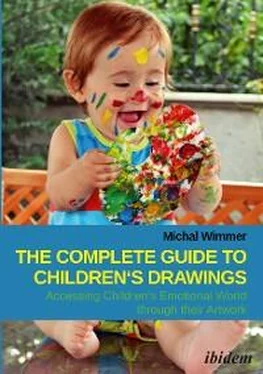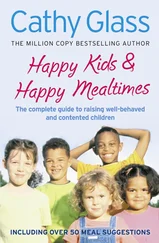However, black is also associated in our culture with authority and momentousness, as in “black tie” events. In Japanese culture, black is a symbol of nobility, age, and experience.
According to Lüscher, black negates any other color and as such symbolizes relinquishment, surrender and abandonment. But black also has an ability to emphasize and empower any color drawn next to it. Kandinsky associated black with eternal silence, without hope.
When analyzing drawings, recall that the use of black is not culturally dependent. In that it is similar to many other elements in children’s drawings, such as houses, which appear in the majority of children’s drawings from diverse cultures in the shape of a triangle placed on top of a square, regardless of the real-life appearance of their lodgings.
Likewise, the use of colors in drawings is not culture-dependent, and when a child draws exclusively in black, it definitely does not mean he is depressed or in mourning. Thus, you can find black drawings even in countries where mourning is represented by other colors, such as red in South Africa, blue in Iran, and the white flags hoisted along the streets of Colombo, Sri Lanka, following the Tsunami disaster.

Figure 2-12:Excessive use of black
Most children use black in their drawings simply because it gives a strong and dramatic effect to the drawing. Figure 2-12 was made by a 3 years and 5 months-old boy, who named it “The world in black”. By doing so, he increased his parent’s anxieties about his general condition. When I checked other drawings he made, it was found, in addition to other graphic indicators, that black was used sporadically, enabling me to calm his parents.

Figure 2-13:Black-less drawing from the ghetto
On the other hand, the next colorful and joyful-looking drawing was made by a girl who lived in a ghetto during the Holocaust, under severe stress and anxiety, before she was killed in an extermination camp.
There are some issues related to black that you must check. First, find out whether the colors in front of your child included only black, or did not include it at all. This may sound weird, but sometimes children simply draw with the colors in their possession. I once met a kindergarten teacher who consistently withheld black crayons from her children, explaining that she didn’t want the children to spoil their drawings by covering them in black. Such behavior could be the source of children’s strong attraction to drawing with black at home.
I do not recommend this approach, because colors are rich with personal meanings for children and it is important that they experience drawing freely and intuitively.
The next issue that you should check is the surrounding in which the drawing was made. Does the child draw differently at home, compared to kindergarten? Do drawings made while staying with grandparents include different colors than usual? Does the phenomenon repeat itself or appear in one drawing only?
If the child continues to draw exclusively in black, I advise checking his behavior when other colors are placed in front of him. Does he ignore them, or does he try them out but prefers using black? It is also important to note the length of time in which he chooses to use black exclusively, similarly to the “pink period” or “heart-shape period” common among girls, which passes naturally with age.
Many children who prefer black argue that it is “the most powerful color”, since it can erase all colors painted underneath. In addition, it forms a strong contrast with the page’s white color. Nevertheless, if the child persists in using black excessively, you must check whether he suffers from some visual problem, perhaps color blindness (if the child’s age allows you to make such a diagnosis). Interestingly, a study conducted among children with learning disabilities, perceptual and visual problems found that drawing on black paper made it easier for them to create a wider variety of shapes and details, probably thanks to the strong contrast provided by black (Uhlin 1979).
In any case, even if the use of black is exaggerated, you must refer to the overall drawing level: Does the child draw in an age-appropriate manner? Does he enjoy drawing? How much pressure does he apply while drawing? If the pressure is very intense, to the point of punching holes in the paper, the use of black may indicate emotional inhibition, internalized fears and fear of criticism.
To conclude, the colors in children’s drawing paint a fascinating picture. Nevertheless, it is important to beware of attributing far-reaching meanings and spiritual symbolism to little children. The combination of meanings of the colors in children’s drawings, combined with the meanings of graphic parameters and the various symbols in other elements, can add a deeper layer of significance to our interpretation of colors and shed light onto the drawing child’s subjective emotional world.
The Meaning of Colors in Children’s Drawings
Red – A dominant and extroverted child who likes to be at the center of attention. He is active and full of enthusiasm. Like challenges and competitions and strongly needs to be the winner. Usually, his behavior is goal-directed – he can get what he wants and does not easily let other children have their way.
Orange – An energetic, enthusiastic boy who loves doing. Usually, very creative and brimming with optimism. Willing to dare and join new experiences, and showing charming mischievousness. Obeying the rules does not come easy to him and he demands clear explanations for every request.
Yellow – A clever boy, highly sensitive to his environment. He is playful and full of joy of life, but not a “troublemaker” like his red friend. He is strongly connected to his family and does not need “the boys” to find interest. Has a rich inner world and good concentration.
Pink – Usually girls who love to be at the center of attention. They feel older than their age and require the environment to treat them accordingly. They are intensely interested in and curious about their femininity and end to give orders and act like “little mothers”.
Blue – An easygoing, calm boy. In his social conduct, he will seek quiet and harmony. He demands logical explanations and refuses to receive answers such as, “Because I said so!” Has a rich and intricate inner world, but it’s important for him to express himself and his wishes.
Purple – A boy with well-developed imagination and intuitions. Demands to be treated with exceptional tolerance, but conducts himself at a personal pace that suits him. He has principles and ideals that guide him and lead his thought and action.
Green – Curious with a passion for learning. He likes new beginnings and transition, and can examine situations in his life in a different and refreshing light. The educational approach to him needs to be liberal, with plenty of free space for action.
Brown – A judicious boy, who usually thinks rationally. As such, he demands and needs logical explanations. In his social conduct, he shows confidence and even leadership skills.
Black – A responsible boy with a presence, needs attention, prefers to be the social leader and decide for everyone.
3 Family Relationships
The parent-child relationship can be a challenging and empowering experience, but also a complex and exhausting one. Some may say parenting is one of the most complex and meaningful tasks in our lifetime and as such, it is rife with changes and internal conflicts. Drawings shed light on parent-child dynamics, helping us understand the reasons behind a child’s behavior and find unique ways to improve the atmosphere and relationship at home.
Читать дальше














